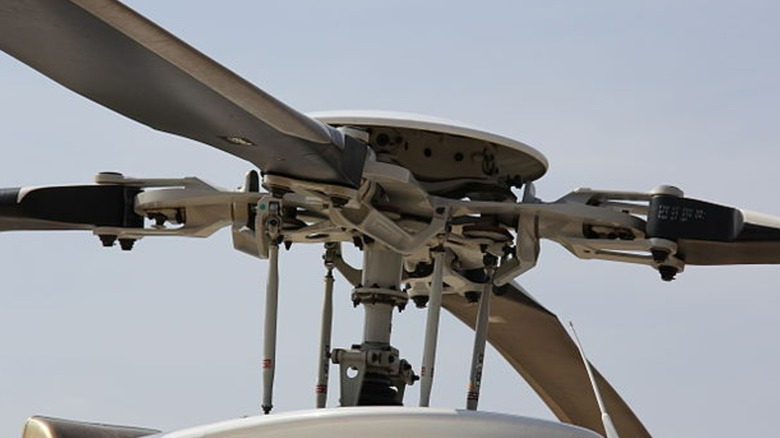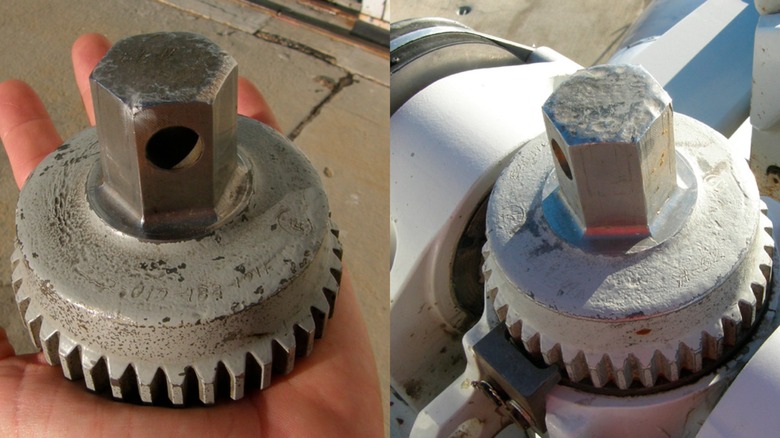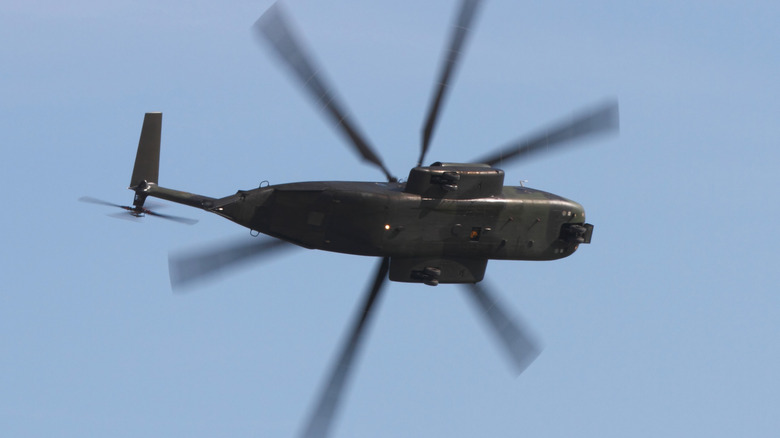What Does The Vital 'Jesus Nut' Do On A Helicopter & Why Is It Called That?
Air travel has evolved tremendously throughout the past century, making it easier than ever for folks to travel vast distances without touching the ground. While much of the press regarding aviation puts the focus on planes and jets, as civilians and military personnel alike most commonly use such means of travel, they're not alone. Let's not forget that helicopters are still very much used, with some civilian helicopters actually proving to be remarkably fast. With their quickly-rotating set of blades, helicopters can lift off without a runway, rising to reach their proper altitude.
The anatomy of a helicopter rotor setup, seen above, is quite fascinating. At the center is the vertical rotor mast, which the four blade grips sit at the top of and, hence the name, hold onto the blades. The mast runs through the upper and lower swash plates, which communicate with the flight controls to let the pilot make adjustments as needed, as well as the ball bearings between them. A vertical control rod is connected to each blade grip, joining them to the entire swash plate assembly below. Holding it all together is the vital mast nut, or Jesus nut, on top, which effectively sandwiches all of these elements into place and prevents them from falling apart.
The mast nut is an essential element to any helicopter, keeping the entire blade assembly in place and attached correctly to the rest of the helicopter. Its purpose, and what could happen if it were to fail, contribute to its religious nickname, which has been in the cultural vocabulary for decades.
The mast nut's nickname is connected to its purpose and potential failure
To say that the Jesus nut is an incredibly important piece to a helicopter would be an understatement. It holds basically the entire rotor system together, keeping the blades from spinning right off of the top in flight or as it fires up on the ground. Thus, if the nut were to somehow break or otherwise disconnect, in any scenario, disaster would almost certainly strike. The loss of the blades in flight would cause the helicopter to suddenly drop, and on the ground, the blades could disconnect and spin out of control, likely resulting in harm to those surrounding the helicopter.
With this in mind, the meaning behind the morbid nickname of this component becomes clear: if the nut fails, it's said that those in or around the helicopter will come face-to-face with Jesus himself in short order. While it's not documented who specifically came up with this nickname, there is an idea of when it came to be. It wasn't uncommon during the Vietnam War — a conflict where helicopters were among the most notable aircraft — for soldiers to reference the mast nut as the Jesus nut for the aforementioned reason. Decades later, it's clear that the moniker stuck.
This all may lead one to think the Jesus nut is something to be concerned about, as if it could simply fly off. In reality, claims alluding to the idea that it frequently fails and sends people to their doom are greatly exaggerated.
The Jesus nut isn't as unpredictable as it seems
Like with virtually any other form of aircraft, helicopter crashes are far from unheard of. Be it due to attacks during war, unanticipated mechanical issues, navigation errors, or other factors, they don't always make clean, safe landings. Considering its importance and the disaster that can come from it malfunctioning, one might be inclined to think that Jesus nut-related crashes are common. It doesn't help that when crashes do happen, there can be speculation online that the Jesus nut is the element to blame over all others, whether the evidence is there or not. As it turns out, though, it's not typically the piece at fault.
In the grand scheme of helicopter crashes or debilitating malfunctions, there are numerous different, more likely causes. Blade fractures, transmission issues, and fluid leaks, are all more common problem points. That's not to say that it's impossible for something to go wrong with the Jesus nut, but there's a degree of embellishment in stories pertaining to its failure rate. Besides, if the Jesus nut was such a liability, then it's safe to say you wouldn't have some of the oldest helicopter models still used by the United States military.
The Jesus nut is undoubtedly vital to the function of a helicopter as well as the safety of those on board. If it were to fail, the consequences could be devastating, but, fortunately, such instances are few and far between.


